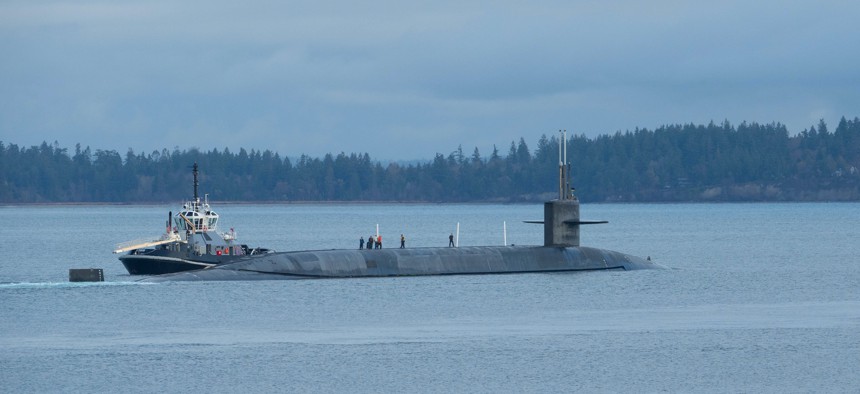
The Ohio-class ballistic missile submarine USS Nevada (SSBN 733) transits the Hood Canal as the boat departs its homeport of Naval Base Kitsap-Bangor, Washington, Dec. 16, 2021. U.S. Navy / Mass Communication 2nd Class Ian Zagrocki
Let’s Correct a Misperception About Nuclear Modernization
An article left the impression that a new fuze would vastly increase the capability of our nuclear arsenal. It’s simply not the case.
As chairman and ranking member on the House Armed Services Strategic Forces Subcommittee, we believe it is important to correct a false impression about a small but important component in the American nuclear arsenal.
Five months ago, the Washington Post published an article about a new nuclear weapon fuze, the mechanism that detonates a warhead at the right time and place. Production of the new fuzes for the Navy’s submarine-launched ballistic missiles reached a new milestone last July, the article reported, and the Air Force’s intercontinental ballistic missiles will soon follow suit.
None of this should be too shocking to those closely following nuclear modernization. The new fuze is over a decade in the making, and the modest upgrades to wires, sensors, batteries, and computing gear ensure that, as one Sandia National Laboratory employee put it, a U.S. nuclear weapon “always works when we want it to and never when we don’t.” In short, they make the American arsenal safer and more reliable—a longstanding and bipartisan goal.
What these new fuzes do not do—and what no current or planned nuclear modernization program does—is increase the yield of existing weapons, or make them easier to launch, or give a whole new target list to Pentagon planners compared to what they already have.
Which is why it was shocking that the key claim put forward in the Post article, backed by an out-of-context quote from a former director of a weapons lab along with others from professors and activists, was that these “astounding pieces of technology” would “roughly double” the hard-target kill capability of the U.S. nuclear arsenal.
To give a sense of scale, any attempt to double America’s nuclear capability would be a gigantic undertaking over several decades, costing hundreds of billions of dollars if not more. Yet the Post article implied all this had already been done, within existing budgets and with few people noticing, simply by fine-tuning some widgets. Depending on their perspective, readers likely interpreted this as either too good to be true or too bad to be believed.
We were stunned by the Post article and sought clarification from the Pentagon. Their answer was simple: these new fuzes, which affect reliability far more than performance, do not really change our nuclear capability. It is clearly understood within the Pentagon that the Post article created a false impression, though they have chosen not to make a public comment.
We believe it is worth correcting the record. When it comes to our nuclear deterrent, the small things matter - especially those that have real-world consequences. The United States is, for the first time in its history, reckoning with two near-peer nuclear armed competitors. China is in the process of growing their nuclear forces from about 350 weapons to one that approaches our own deployed arsenal in size. Russia is nearly complete with a comprehensive modernization of its nuclear systems, continues to develop and field new and exotic nuclear capabilities, and is loudly rattling its nuclear saber in its invasion of Ukraine.
These developments in China and Russia are troubling enough on their own. But if the Post’s article is to be believed, American nuclear forces just took a quantum leap forward, a situation which could be used by Beijing and Moscow to justify an even greater expansion of their respective nuclear arsenals.
It is also abundantly clear that Russia’s attempt to conquer Ukraine has ushered in a new geopolitical era. It is too soon to tell what this new world will look like, but it is likely that nuclear weapons will be more salient than they had been since the end of the Cold War. If exaggerated impressions of American weapons in foreign capitals are unhelpful in addressing this fundamental challenge, neither are impassioned calls at home to drastically cut our nuclear arsenal based on seriously faulty assumptions about its capability.
Maybe focusing on this one Post article is making a mountain out of a molehill—we’ll never know for sure whether our competitors took note. But false impressions tend to take on lives of their own. When it comes to our nuclear arsenal, we need to get the facts right.
Rep. Jim Cooper, D-Tenn., and Rep. Doug Lamborn, R-Colo., are the chairman and ranking member of the House Armed Services Strategic Forces Subcommittee.
NEXT STORY: Defense One Radio, Ep. 97: Putin's long war



